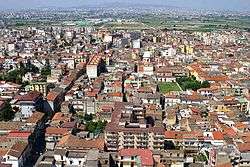Acerra
| Acerra | |
|---|---|
| Comune | |
 Aerial photo of Acerra | |
 Acerra Location of Acerra in Italy | |
| Coordinates: 40°57′N 14°22′E / 40.950°N 14.367°ECoordinates: 40°57′N 14°22′E / 40.950°N 14.367°E | |
| Country | Italy |
| Region | Campania |
| Metropolitan city | Naples (NA) |
| Frazioni | Gaudello, Pezzalunga |
| Government | |
| • Mayor | Raffaele Lettieri (UdC) |
| Area | |
| • Total | 54.71 km2 (21.12 sq mi) |
| Elevation | 26 m (85 ft) |
| Population (31 December 2017) | |
| • Total | 59,910 |
| • Density | 1,100/km2 (2,800/sq mi) |
| Demonym(s) | Acerrani |
| Time zone | UTC+1 (CET) |
| • Summer (DST) | UTC+2 (CEST) |
| Postal code | 80011 |
| Dialing code | 081 |
| Patron saint | St. Cuono and Conello |
| Saint day | 29 May |
| Website | Official website |
Acerra [aˈtʃɛrra] is a town and commune of Campania, southern Italy, in the Metropolitan City of Naples, about 15 kilometres (9 miles) northeast of the capital in Naples. It is part of the Agro Acerrano plain.
History
Acerra is one of the most ancient cities of the region, probably founded by the Osci with the name of Akeru (Latin: Acerrae, Ancient Greek: Ἀχέρραι). It first appears in history as an independent city during the great war of the Campanians and Latins against Rome; shortly after the conclusion of which, in 332 BC, the Acerrani, in common with several other Campanian cities, obtained the Roman "civitas," but without the right of suffrage. The period at which this latter privilege was granted them is not mentioned, but it is certain that they ultimately obtained the full rights of Roman citizens.[1]
In the Second Punic War it was faithful to the Roman alliance, on which account it was besieged by Hannibal in 216 BC, and being abandoned by the inhabitants in despair, was plundered and burnt. But after the expulsion of Hannibal from Campania, the Acerrani, with the consent of the Roman senate, returned to and rebuilt their city in 210 BC.[2]
Acerra served as a Roman base during the Social War in 90 BC.[3] During the Social War it was besieged by the Samnite general, Gaius Papius Mutilus, but offered so vigorous a resistance that he was unable to reduce it.[4] Virgil praises the fertility of its territory, but the town itself had suffered so much from the frequent inundations of the river Clanius, on which it was situated, that it was in his time almost deserted.[5] It subsequently received a colony under Augustus,[6] and Strabo speaks of it in conjunction with Nola and Nuceria, apparently as a place of some consequence. It does not seem, however, to have retained its colonial rank, but is mentioned by Pliny as an ordinary municipal town.[7][8]
In 826 the Lombards built here a castle, later destroyed by Bono of Naples. In 881 it was sacked by the Saracens. Later it was a Norman possession, the seat of a county. As part of the Kingdom of Naples, it was a fief of the Aquino, the Origlia, the Orsini del Balzo and, from 1496 until 1812, the Cardenas. From 1927 it was part of the province of Terra di Lavoro. On 1 October 1943, whilst the city was occupied by the forces of Nazi Germany, the Germans massacred 110 civilians, in one of the bloodiest massacres in Campania; a memorial was erected to the victims.[9]
Main sights
- Acerra Cathedral, originally built over an ancient temple of Hercules and remade in the 19th century. It houses some Baroque canvasses from the 17th century. Annexed is the Bishop's Palace.
- Church of Corpus Domini (16th century).
- Church of Annunziata (15th century), with a 12th-century crucifix and a 15th-century Annunciation attributed to Dello Delli.
- Church of San Pietro (16th-17th centuries)
- Baronial Castle.
- Archaeological area of Suessula. Location 40°59'23.47"N 14°23'53.41"E
References
- ↑ Livy. Ab Urbe Condita Libri (History of Rome). 8.17.
- ↑ Livy. Ab Urbe Condita Libri (History of Rome). 23.17, 27.3.
- ↑ Canby, Courtland. The Encyclopedia of Historic Places. (New York: Facts of File Publications, 1984) p. 6
- ↑ Appian, B.C. 1.42, 45.
- ↑ Virg. G. 2.225; and Servius ad loc.; Sil. Ital. 8.537.
- ↑ Lib. Colon. p. 229.
- ↑ Strabo. Geographica. v. pp. 247, 249. Page numbers refer to those of Isaac Casaubon's edition.
- ↑ Pliny. Naturalis Historia. 3.5.9.
- ↑ http://www.oblomagazine.net/magazine/2012/10/08/eccidio-nazista-del-1943-sistemata-e-scoperta-una-lapide-a-memoria-della-strage/
![]()
External links
- Acerrae in William Smith’s Dictionary of Greek and Roman Geography (1854).
